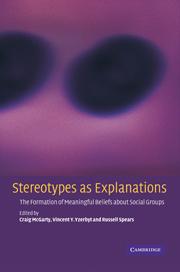Book contents
- Frontmatter
- Contents
- List of figures
- List of contributors
- Preface
- 1 Social, cultural and cognitive factors in stereotype formation
- 2 Stereotype formation as category formation
- 3 Subjective essentialism and the emergence of stereotypes
- 4 The role of theories in the formation of stereotype content
- 5 Illusory correlation and stereotype formation: making sense of group differences and cognitive biases
- 6 Dependence and the formation of stereotyped beliefs about groups: from interpersonal to intergroup perception
- 7 Four degrees of stereotype formation: differentiation by any means necessary
- 8 From personal pictures in the head to collective tools in the world: how shared stereotypes allow groups to represent and change social reality
- 9 Conclusion: stereotypes are selective, variable and contested explanations
- References
- Author index
- Subject index
9 - Conclusion: stereotypes are selective, variable and contested explanations
Published online by Cambridge University Press: 22 September 2009
- Frontmatter
- Contents
- List of figures
- List of contributors
- Preface
- 1 Social, cultural and cognitive factors in stereotype formation
- 2 Stereotype formation as category formation
- 3 Subjective essentialism and the emergence of stereotypes
- 4 The role of theories in the formation of stereotype content
- 5 Illusory correlation and stereotype formation: making sense of group differences and cognitive biases
- 6 Dependence and the formation of stereotyped beliefs about groups: from interpersonal to intergroup perception
- 7 Four degrees of stereotype formation: differentiation by any means necessary
- 8 From personal pictures in the head to collective tools in the world: how shared stereotypes allow groups to represent and change social reality
- 9 Conclusion: stereotypes are selective, variable and contested explanations
- References
- Author index
- Subject index
Summary
The chapters in this book make a number of distinct contributions that help us understand the importance of explanation in stereotype formation. Despite the distinctiveness of the various contributions, a number of key themes emerge and recur. Before addressing these in more detail it is useful to remind ourselves of perhaps one key theme that has guided this volume and gives all of its contributions some common ground. Perhaps more implied than explicitly stated, all of the contributions focus on stereotype formation (and more generally ‘stereotyping’) as a dynamic psychological process embedded in intergroup relations. This point may sound like a truism, but in our view, the partial nature of some previous approaches flows from an emphasis on one or other of these two components. That is, much previous and contemporary research has tended to focus on stereotyping as a psychological process, but to neglect the social and contextual dimensions of this process (e.g., the importance of own group membership, content, the nature of the intergroup relations). Alternatively, where research has recognized the social dimension of stereotyping, it has often neglected the dynamic explanatory psychological processes involved (stereotypes as fixed structures, percepts, pictures in our heads, epiphenomena of intergroup relations or culture). If there is a common theme that brings many of the current contributions together, then, it is the attempt to integrate the cognitive and the social aspects of the stereotyping process by attention to both cognitive and social levels of explanation and analysis.
- Type
- Chapter
- Information
- Stereotypes as ExplanationsThe Formation of Meaningful Beliefs about Social Groups, pp. 186 - 199Publisher: Cambridge University PressPrint publication year: 2002
- 3
- Cited by



